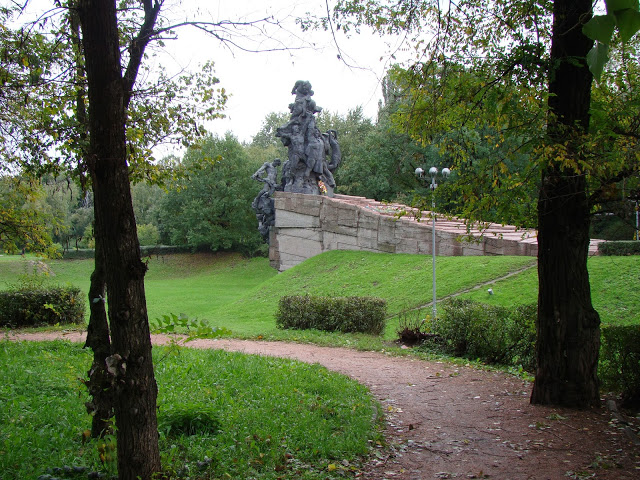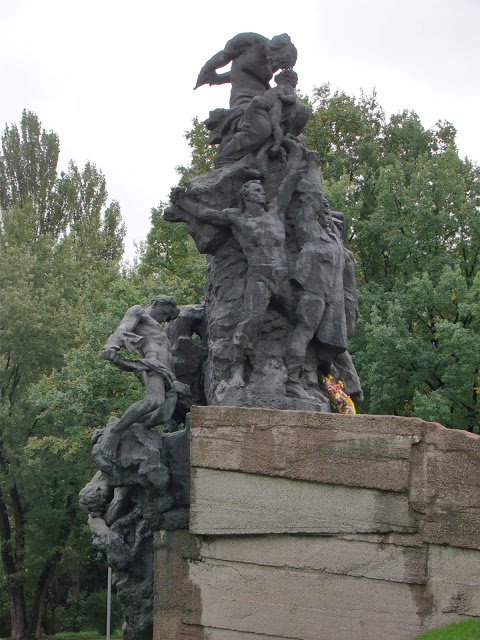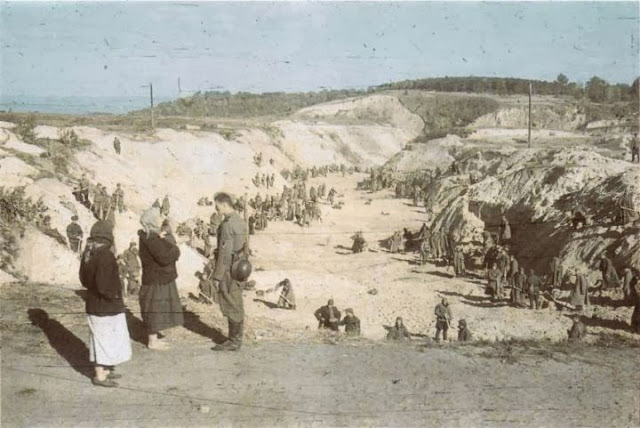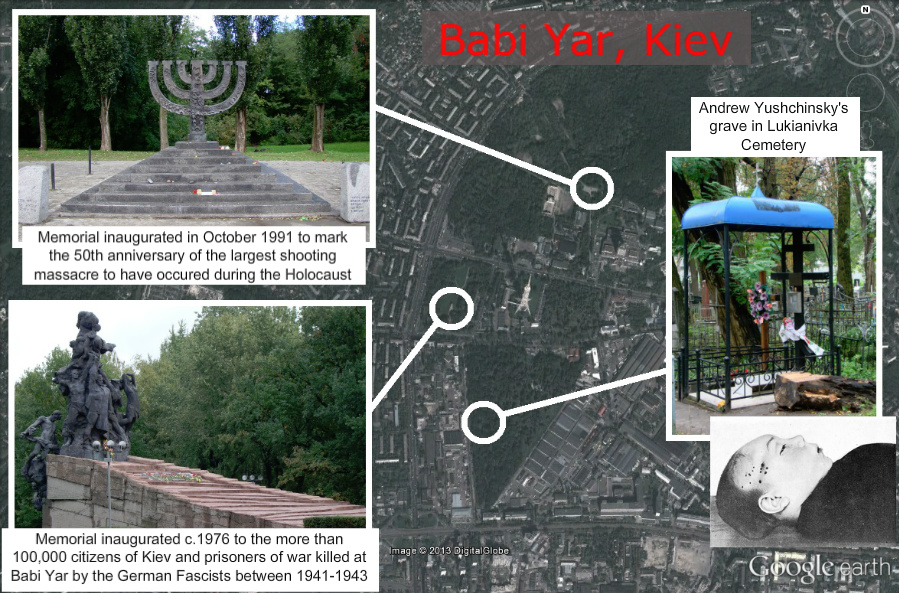[Note: As this is taken from an
archived site, some links and videos below may not be working.]
From one blood libel to another. Part 1.
Shortly before my
September 2013 trip to Kiev I leant by chance that Andrew Yushchinsky,
the 13 year old boy whose murder in March 1911 prompted the famous
ritual murder trial, was buried close to the ravine named Babi Yar in
the Ukrainian city of Kiev. The ravine in which the Germans are claimed
to have killed anywhere up to 200,000 people, mostly Jews, during the
Second World War.
I thought it might be
interesting to visit and photograph his grave (which is in a cemetery
literally across the road from the main Babi Yar memorial) and also try
and find and photograph many of the locations connected, and alleged to
be connected, with his murder and the subsequent trial at which his
accused murderer Mendel Beilis was acquitted. Although the jury did
considered it proven that Yushchinsky had suffered forty-seven separate
puncture wounds to his head and body, resulting in an almost total loss
of blood, and that his murder happened on the premises of
the Jewish-owned brick factory in which Beilis was employed.
I'm grateful to numerous
Russian websites that enable me to find many of the locations that I
will detail in this and subsequent posts, but the following to deserve
special mention: Kievan historian Michael Kalnitsky's article
"Charitable Institutions of the Zaitsevs" (Благотворительные
учреждения Зайцевых), and Kievan art, architecture and history
enthusiast 'agritura' and her article "Kiev: A Walk Through Lukianivka,
Part II" (Киев
/ Прогулка по Лукьяновке. Часть 2).


The two photos above are
of the Soviet memorial designed by Anatoly Ignashchenko which was
unveiled in July 1976. The statue is just one of several
memorials situated in Babi Yar to the alleged murder of up to 200,000
people by the Germans and their cohorts at the site (I photographed
others not mentioned
here), some Jewish, some Christian, some neither—including this one.
At the foot of this statue are three plaques installed in 1991; in
Ukrainian, Russian and Yiddish, which read: "Here, in
1941–1943, more than one hundred thousand citizens of the city of Kyiv
and prisoners of war were shot by German Fascist invaders."
This post isn't about what really did, or didn't happen at Babi Yar
during the German occupation of Kiev, but to briefly detail the opposing
revisionists and exterminationalist positions: It is claimed that
immediately following the German conquest of Kiev the Germans ordered
all the Jews in the city to congregate near the ravine on September 29,
1941 to be deported, but instead of deporting them, they shot 33,771 of
them within two days. This precise figure of 33,771 appears in the
Einsatzgruppen C report of October 7, 1941, which revisionists such
as Jürgen Graf (p.
26f) believe "is
a forgery, or it is formally authentic but historically inaccurate," a
view which, surprisingly, at least one exterminationalist historian
almost agrees with. Professor Victoria Khiterer (p.7f)
writes that "if
only 33,771 Jews were killed, it is not possible to explain the
disappearance of the rest of the 115,000 - 135,000 Jews stranded in Kiev
at the start of the German occupation ... Einsatzgruppe C execution unit
did not want to write to Berlin the truth that they were not able to
count the number of their victims"!

Burying 33,771 - 169,000
Jews in the Babi Yar ravine in early October 1941.
Following this initial
massacre at Babi Yar, the Germans are claimed to have dynamited the
walls of the ravine and forced Kievans to use the dislodged earth cover
the 33,771 to 169,000 corpses. Something which was supposedly caught on
camera by German soldier Johannes
Haehle.
In the subsequent 24 months that the Germans occupied Kiev numerous
further massacres—but individually smaller in scale than the first—is
claimed to have happened at Babi Yar. One hundred thousand (there, or
thereabouts) is the figure currently recognised by the majority of
exterminationalists as the number of people murdered and buried at Babi
Yar during the German occupation.
The c.100,000 bodies buried at Babi Yar are claimed to have been exhumed
and cremated in a six week period beginning at some point in July or
August 1943. Mineral exploration geologist, revisionist and aerial
photography expert John Ball has asserted that
a September 26, 1943 German Luftwaffe photograph of the part of the
ravine (near the Jewish cemetery) where it is claimed the cremation
operation was centred, shows no evidence of the constant vehicle and
foot traffic needed to supply fuel for the cremating c.100,000 people,
nor does the ravine itself show any sign of having recently been
subjected to extensive excavations. The complete lack of evidence that
tens-of-thousands of corpses were ever unearthed and cremated in Babi
Yar was also noted by American journalist William H. Lawrence, who was
given a guided tour of Babi Yar in late November 1943 by the Soviets who
had liberated Kiev earlier that month. Lawrence wrote of
being told that the corpses of 50,000 to 80,000 Jews had been exhumed
and cremated at the site only a few weeks earlier: "On
the basis of what we saw, it is impossible for this correspondent
to judge the truth or falsity of the story told to us."
On the other hand, there are Germans who confessed to partaking in, or
knowing of the massacres at Babi Yar; testimonies from sonderkommados
forced to partake in the cremations; contemporary diaries that mention
large scale shootings, and finally the Einsatzgruppen C report of
October 7, 1941. Revisionists don't contest that several thousand Jews
may have been shot by the Germans in Kiev, in reprisal actions (Graf,
p. 27f), and according to Michael
Nikiforuk, even a major newspaper in Kiev has rubbished the orthodox
Babi Yar story.
That's more than enough back-ground on the alleged massacres, burials
and cremations at Babi Yar. On to the actual topic of this post, the boy
who is buried just metres away from the Babi Yar memorial.
Andrew Yushchinsky
I shot this short video
on my Ipod, standing beside the Soviet memorial at Babi Yar. At the
start of the video you can just see a glimpse through the trees of the
red-painted wall of the Lukianivka Cemetery where Andrew Yushchinsky is
buried.
The entrance gates to
Lukianivka Cemetery, no. 7 Dorogozhytska Street, Kiev.
The grave of Andrew
Yushchinsky (with the blue canopy, which was added in 2006)
Russian text reads:
Здесь почивают мощи
Св. отрока-мученика
Андрея
(Ющинского).
Увенчан Мученическим
венцом
на 13-м году, 12/25
марта 1911г.
Святьiй (recte: Святьий)
мучениче Андрее.
моли бога о нас.
Approximate translation
(improvements welcomed)
Here lie the relics of
Young-martyr St. Andrew
(Yushchinsky).
Enwreathed with the
crown of martyrdom
aged 13-years, between
12/25 March 1911.
Saint Martyr Andrew.
Pray to God for us.
In the photo above
you can see a religious
icon of Yushchinsky—who is considered a saint by some members of
the Orthodox church—alongside representations of the "cave" in which
his body was found, the Zaitsev brick factory in which the jury
judged that he'd been murdered, and in the back ground Saint
Sophia's Cathedral in Kiev.
This engraved stone
tablet was another addition to Yushchinsky's grave in 2006. The text
reads:
"12 березня 1911 року в
Києві, на вулиці Верхньоюрківській (recte: Верхньоюрківська), що
на Лук'янівці, в одному із приміщень цегельного заводу, який належав
єврейській хірургічній лікарні (завідував нею купець Марко Іонів
Зайцев), було скоєно жахливий злочин. 13-річному хлопчикові Андрію
Ющинському затисли рота й колючим знаряддям нанесли рани в тім’я,
потилицю, скроні, шию, що супроводжувалося пораненнями мозкової вени,
артерії, лівої скроні та шийної вени. Це призвело до сильної кровотечі.
Він втратив до п’яти склянок крові. Ющинському знову було нанесено тією
ж зброєю рани в тулуб, що супроводжувалося пораненням легень, печінки,
правої нирки і серця, в ділянку якого направили решту ударів. Усього
було 47 ударів. Це викликало мученицькі страждання Ющинського. Тіло було
повністю обезкровлене, внаслідок чого наступила смерть. (З рішення
Київського суду присяжних)"
The Ukrainian text translates to English as:
"March 12, 1911 in Kiev,
in Lukyanivka on Verkhne-Yurkovsky Street, in one of the brick factory
buildings that belonged to the Jewish Surgical Hospital (in the
management of merchant Marco Ion Zaitsev), a terrible crime was
committed. 13-year-old Andrew Yushchinsky was gagged at the mouth and
wounds were inflicted on the forehead, back of the head, the temples,
and neck with a barbed instrument, accompanied by wounds to the cerebral
veins and arteries on the left temple and cervical veins. This led to
heavy bleeding. He lost up to five glasses of blood. With the same
weapon wounds were again inflicted on Yushchinsky's body, accompanying
injuries to the lungs, liver,right kidney and—the area to which the last
blows were directed—the heart. There were 47 blows. This caused
Yushchinsky's martyrdom of agony. The body was fully bled white, and as
a result death ensued. (From the verdict of the Kiev court jury)"
The text is based on the
first of two questions the jury at the murder trial (which was conducted
in Russian) of Mendel Beilis were instructed to answer. It's not a
faithful representation, as in the trial transcript there is no mention
of 'martyrdom' ; Ukrainian: мученицькі; Russian: мученические (page
300 of volume III of the trial
transcript).
Below is
the facsimile of the original text from the trial transcript, which does
include some Cyrillic characters which are no longer
part of the Russian alphabet.
Following is a transcription in modern Russian, taken from this
site:
Старшина присяжных
читает:
«Доказано ли, что 12-го
марта 1911 года в Киеве, на Лукьяновке, по Верхне-Юрковской улице, в
одном из помещений кирпичного завода, принадлежащего еврейской
хирургической больнице и находящегося в заведывании купца Марка Ионова
Зайцева, тринадцатилетнему мальчику Андрею Ющинскому при зажатом рте
были нанесены колющим орудием на теменной, затылочной, височной
областях, а также на шее раны, сопровождавшиеся поранениями мозговой
вены, артерий, левого виска, шейных вен, давшие вследствие этого
обильное кровотечение, а затем, когда у Ющинского вытекла кровь в
количестве до 5-ти стаканов, ему вновь были причинены таким же орудием
раны в туловище, сопровождавшиеся поранениями легких, печени, правой
почки, сердца, в область которого были направлены последние удары,
каковые ранения в своей совокупности числом 47, вызвав мучительные
страдания у Ющинского, повлекли за собой почти полное обескровление тела
и смерть его».
Ответ присяжных
заседателей:
— Да, доказано.
Translated:
Foreman of the jury
reads:
"Is it proved whether,
on the 12th of March 1991 in Kiev, in Lukyanivka on Verkhne-Yurkovsky
Street*, In one of the brick factory premises appurtenant to the Jewish
Hospital Surgical and placed under the superintendence of the merchant
Mark Jonoff Zaitsev, the thirteen year old Andrey Yuschinsky had wounds
inflicted upon him with a sharp tool on the forehead, the head, the
temples, and also on the neck; that the veins and arteries on the left
temple were pierced, thus causing an abundant loss of blood; that after
five glasses of blood had come out, new wounds with the same tool were
inflicted on the body, piercing the lungs, the liver, the right kidney,
the heart, where the last blow was struck; and that such wounds,
numbering 47, caused painful suffering to Yuschinsky, led to almost
complete loss of blood, and to his Death?"
The jury responded:
— Yes, it is proved.
* This road was renamed Otto
Schmidt Street (улица Отто Шмидта) during WWII.
Thanks to Anon. for
providing the translations from Ukrainian and Russian text, although the
translation from the trial transcript is mostly taken from this article
'The Beilis Affair' (pdf
format) written in 1914-1915 and found in the online archives of the
American Jewish Committee.
It's interesting to note
that in all the half-dozen or so books I've checked which attempt to
refute the jury's decision about Yuschinsky being murdered in the Jewish
brick factory, and blame his murder on a gang of local small-time
criminals, none of them quote the the above passage in full.
Much more on this to
come.
------------------------------
"When a Jew, in America or in South Africa, talks to
his Jewish companions about 'our' government, he means the
government of Israel."
- David Ben-Gurion, Israeli Prime Minister

Viva Palestina!
Latest Additions
- in English
What is this Jewish
carnage
really about? - The background to
atrocities
Videos on Farrakhan, the Nation of Islam and Blacks and Jews

How Jewish Films and Television Promotes bias Against
Muslims
Judaism is Nobody's
Friend
Judaism is the Jews' strategy to
dominate non-Jews.
Jewish War Against
Lebanon!
Islam and Revolution
By Ahmed Rami
Hasbara -
The Jewish manual
for media deceptions
Celebrities bowing to their Jewish masters

Elie Wiesel - A Prominent False Witness
By Robert Faurisson
The Gaza atrocity 2008-2009

Iraq - war and occupation
Jewish War On
Syria!
CNN's Jewish version of "diversity"
- Lists the main Jewish agents
Hezbollah the Beautiful
Americans, where is your own Hezbollah?
Black Muslim leader Louis Farrakhan's Epic Speech in Madison Square
Garden, New York
 - A must see!
- A must see!
"War on Terror" -
on Israel's behalf!
World Jewish Congress: Billionaires, Oligarchs, Global Influencers for Israel
Interview with anti-Zionist veteran Ahmed Rami of Radio Islam
- On ISIS, "Neo-Nazis", Syria, Judaism, Islam, Russia...
Britain under Jewish
occupation!

Jewish World Power
West Europe
East Europe
Americas
Asia
Middle East
Africa
U.N.
E.U.
The Internet and
Israeli-Jewish infiltration/manipulations
Books
- Important collection of titles
The Judaization of
China
Israel: Jewish Supremacy in Action
- By David Duke
The Power of Jews in France
Jew Goldstone appointed by UN to investigate War Crimes in Gaza

The best book on Jewish Power
The Israel Lobby
- From the book
Jews and Crime - The archive
Sayanim - Israel's and Mossad's Jewish helpers abroad
Listen to Louis Farrakhan's Speech
- A must hear!
The Israeli Nuclear Threat
The "Six
Million" Myth
"Jewish History"
- a bookreview
Putin and the
Jews of Russia
Israel's attack on US warship USS Liberty
- Massacre in the Mediterranean
Jewish "Religion" - What is
it?
Medias
in the hands of racists
Strauss-Kahn - IMF chief and member of Israel lobby group

Stop Jewish Apartheid!
The Jews behind Islamophobia
Israel controls U.S. Presidents
Biden, Trump, Obama, Bush, Clinton...
The Victories of Revisionism
By Professor Robert Faurisson
The Jewish hand behind Internet
The Jews behind Google, Facebook, Wikipedia,
Yahoo!, MySpace, eBay...
"Jews, who want to be decent human beings, have to renounce being Jewish"
Jewish War Against Iran
Jewish Manipulation of World Leaders

Al Jazeera English under
Jewish infiltration

Garaudy's "The Founding
Myths
of Israeli Politics"
Jewish hate against Christians
By Prof. Israel Shahak
Introduction to Revisionist
Thought
- By Ernst Zündel
Karl Marx: The Jewish Question
Reel Bad Arabs
- Revealing the racist Jewish Hollywood propaganda
"Anti-Semitism" - What is it?
Videos
 - Important collection
- Important collection
The Jews Banished 47 Times in 1000 Years - Why?
Zionist
strategies
- Plotting invasions, formenting civil wars, interreligious strife,
stoking racial hatreds and race war
The International Jew
By Henry Ford
Pravda interviews Ahmed Rami

Shahak's
"Jewish History,
Jewish Religion"
The Jewish plan to destroy the Arab countries
- From the World Zionist Organization
Judaism and Zionism inseparable
Revealing photos of the Jews 
Horrors of ISIS Created by Zionist Supremacy
- By David Duke
Racist Jewish Fundamentalism
The Freedom Fighters:
 Hezbollah
- Lebanon
Hezbollah
- Lebanon
 Nation of Islam
- U.S.A.
Nation of Islam
- U.S.A.
Jewish Influence in America

- Government, Media, Finance...
"Jews" from
Khazaria stealing the land of Palestine
The U.S. cost of supporting Israel
Turkey, Ataturk and
the Jews

The truth about the Talmud
Israel and the Ongoing Holocaust in Congo
Jews DO control the media -
a Jew brags!
- Revealing Jewish article
Abbas - The Traitor
Protocols of Zion
- The whole book!

Encyclopedia of the
Palestine Problem
The
"Holocaust" - 120 Questions and Answers
Quotes
- On Jewish Power / Zionism
Caricatures / Cartoons

Activism!
- Join the Fight!





































